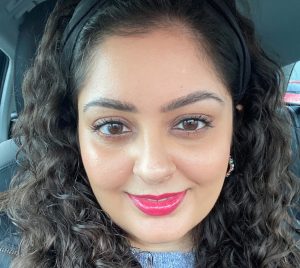Free to be me: Reflecting on my South Asian heritage
In celebration of South Asian Heritage Month, Jaspreet, Clinical Director of Pharmacy and Physical Health Services at Bradford District Care NHS Foundation Trust and Bradford District and Craven Mind Trustee, considers how her heritage and community have shaped her identity.
As a woman born into a Sikh Indian Punjabi family in the UK in the 1980s, it is fair to say that I struggled with my identity significantly growing up. I never really knew where I fitted in, felt awkward going out in traditional Punjabi clothing for fear of being stared at, and always felt somewhat different to others in my community, who seemed to embrace their Panjabi heritage completely. I know now that many 2nd and 3rd generation South Asian immigrants have similar experiences where they feel ‘caught’ between 2 cultures. Reflecting on this now, however, it is evident that we have created our own British South Asian culture, which is diverse, vibrant, and unique. It doesn’t need to be defined by one or the other, it is a wonderful melting pot of multiculturalism.
I grew up in a multigenerational household with my grandparents and parents, which of course is extremely common in Sikh and wider South Asian communities but very different to the typical British household. The Sikh community places a strong emphasis on family and intergenerational relationships which is one of our strengths. Elders pass down wisdom, traditions, values, and the history of our people. The Sikh community has endured much over the last century, with the horrors of the partition of India in 1947 and more recently the Sikh genocide in 1984. When I think about how my grandparents came to this country in the 1960s, not knowing the language, having little to no money and experiencing racist abuse daily, I am in awe of them and their strength, to not just survive, but to thrive, so their children could have a better life.

When I consider my identity today, it strikes me how much of who I am, personally and professionally, has been shaped by Sikh values and beliefs and it is those values and beliefs that allow me to be my authentic self.
These struggles have formed part of the identity of our people over time and Sikhs are known all over the world for their strong sense of social justice and shared humanity. Nowhere is this more evident than through the work of gurdwaras, the Sikh place of worship. They are vital community hubs where people come together for worship, and community service and to provide free meals to all through community kitchens (langar). Many gurdwaras provided free meals to emergency services, the homeless and anyone in need during the COVID-19 pandemic. Gurdwaras also provide language classes that help the younger generation learn Punjabi and stay connected to their heritage. Communities coming together to do ‘seva’ (service) at gurdwaras reinforce the idea that everyone is welcome which in turn fosters a sense of belonging and togetherness.
The solidarity and activism of the Sikh community have inspired me to advocate for justice and equality, reinforcing my commitment to these principles through my work as a specialist mental health pharmacist and charity trustee for two mental health charities working with people with severe mental illness (SMI). People with SMI experience stigma, isolation, and discrimination and are known to have a significantly reduced life expectancy compared to the general population. The founder of Sikhism, Guru Nanak Dev Ji, emphasized the importance of equality for all human beings through his teachings and this resonates with me today as I try to help and support people with SMI to live longer, happier, healthier lives.
When I consider my identity today, it strikes me how much of who I am, personally and professionally, has been shaped by Sikh values and beliefs and it is those values and beliefs that allow me to be my most authentic self.
To find out more about severe mental illness and physical health checks, visit the Healthy Mind’s website.
Posted on: 16th July 2024